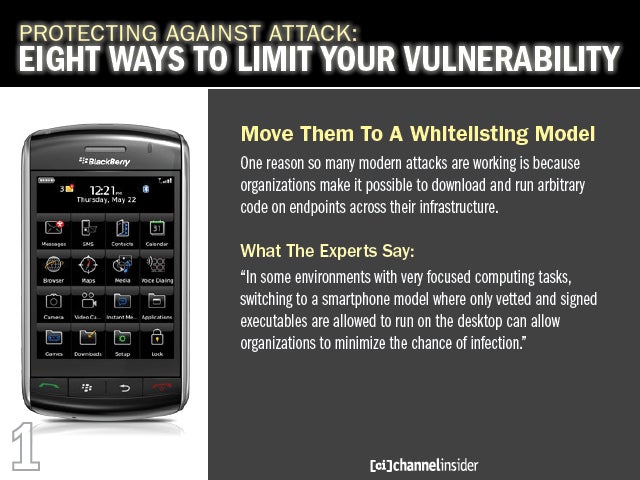 Move Them To A Whitelisting Model
Move Them To A Whitelisting Model One reason so many modern attacks are working is because organizations make it possible to download and run arbitrary code on endpoints across their infrastructure.
What The Experts Say:
"In some environments with very focused computing tasks, switching to a smartphone model where only vetted and signed executables are allowed to run on the desktop can allow organizations to minimize the chance of infection."
 Fine Tune Their Configuration Management
Fine Tune Their Configuration Management A default deny model is not always possible and takes time to develop-but that doesnt mean an organization should throw up its hands.
What The Experts Say:
"As an interim measure to secure against attacks, DVLabs advises implementation of strong and comprehensive configuration management."
 Build Security Into Web 2.0 Applications
Build Security Into Web 2.0 Applications As services keep moving to the cloud, attackers are increasingly shifting their sights to Web applications, looking for low-hanging vulnerabilities.
What The Experts Say:
"Companies need to be very careful about moving more and more functionality onto the Web without ensuring its security."
 Set Up Developer Education
Set Up Developer Education Setting up security training for developers who code Web applications-supported by automated testing tools-will greatly diminish risk of attacks on critical applications.
What The Experts Say:
"The potential impact of deploying new Web applications is rarely understood. Many times these applications directly access sensitive information, and if compromised, give attackers the means to steal this data quickly and easily."
 Have Employees Log Off Websites Before Clicking Untrusted Links
Have Employees Log Off Websites Before Clicking Untrusted Links A lot of CSFR attacks know that many users tend to stay logged into important Web sites and leverage that.
What The Experts Say:
"In order to help prevent Cross Site Request Forgery attacks, it is important to log off of important websites prior to clicking links in email or on untrustworthy websites."
 Patch Religiously
Patch Religiously So many attacks today take advantage of well-known vulnerabilities. Automating your clients patching is one of the most effective ways of greatly reducing their risk of attack.
What The Experts Say:
"It is more important than ever for organizations to have an accurate inventory of user applications and a defined patch strategy."
 Establish A Point Man
Establish A Point Man Help your client identify one person to take responsibility for keeping up to date on vulnerability announcements and attack trends by subscribing to mailing lists and industry RSS feeds. Or better yet, become that point man
"Organizations should designate specific security personnel with the job of monitoring public announcements of new vulnerabilities and widespread attacks."
 Monitor For Anomalies
Monitor For Anomalies Attackers these days dont just announce themselves. Your customers have got to be on the hunt for unusual network behavior and other clues of attack in order to stop problems before they do real damage.
What The Ex
"Organizations should continuously monitor for anomalous and suspicious behavior on their computer systems and networks to detect attacks early on and minimize the damage."

